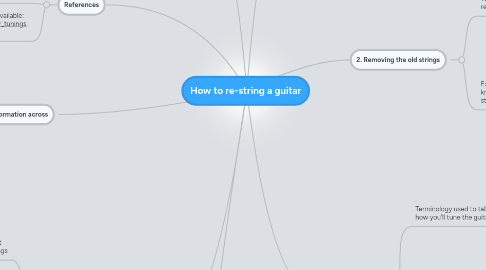
1. 3. Putting the new strings on
1.1. Terminology used to talk about how you'll put on the new strings
1.1.1. Place over the bridge of the guitar
1.1.2. Put between the grooves on the nut
1.1.3. Thread through the holes on headstock
1.1.4. Cut excess string using wire cutters
1.1.5. Order: E,A,D,G,B,E
1.2. Explaining to someone who doesn't know the terminology of placing new strings on the guitar
1.2.1. Bridge: The bridge is the raised section at the bottom of the guitar that allows the strings to rest on. It is also used to control the action of the guitar (The height the strings are from the fretboard)
1.2.2. Grooves on the nut: The nut is at the top of the guitar below the headstock, the strings are place between the 'grooves' to keep them in the right place on the fretboard.
1.2.3. Headstock: The headstock is where the tuning keys holes are that allow the strings to be fed through. There are 6 in total on the headstock (one for each string)
1.2.4. Cut excess string: The string will always need cutting once the guitar has been tuned and all the strings are in the right place. You'll use a 'wire cutter' to to cut this excess string as the strings are normally made from brass.
1.2.5. The order of the strings: The order of the strings have to be place in the following order (bottom to top) E,A,D,G,B,E. The bottom E is the thickest string and the top E is the thinnest. The thinner the string, the higher in pitch the sound is.
2. Ways of getting your information across
2.1. Diagrams
2.2. Videos
2.3. Presentations
2.4. visual demonstrations
2.5. Reading books on the subject
3. References
3.1. Wikipedia. (2013). Electronic tuner. Available: http://en.wikipedia.org/wiki/Electronic_tuner. Last accessed 11th November 2013. (1)
3.2. Wikipedia. (2013). List of guitar tunings. Available: http://en.wikipedia.org/wiki/List_of_guitar_tunings. Last accessed 11th November 2013. (2)
4. When is it a good time to use technical language?
4.1. I think it's best to use Jargon as soon as possible. When teaching it's best to use the right language sooner than later as then the person can learn what they're doing (in this case re-stringing a guitar) whilst using the right technical language which will help them better understand what they're doing now and for the future. Also if the person learns and uses Jargon straight away, they can use this knowledge to teach other people if they wish.
5. How to persuade and influence
5.1. Using a calm tone of voice and not getting angry or frustrated when the person doing the job gets it wrong.
5.2. Writing down notes or instructions to help them if they aren't the type of person that learns verbally or physically
5.3. Giving good examples and making sure you yourself are using the right technique to get the job done.
6. 1. Start by buying the right strings
6.1. Terminology used to talk about different types of strings.
6.1.1. Light
6.1.2. Medium-light
6.1.3. Medium
6.1.4. Extra light
6.2. How to explain to someone who doesn't know the terminology of guitar strings.
6.2.1. Each weight of the strings will determine what the guitar will sound like when played. E.g. the heavier the string the richer the sound.
7. 2. Removing the old strings
7.1. Terminology used to talk about removing the strings
7.1.1. Taking out the pegs
7.1.2. Turning the tuning keys
7.1.3. Cleaning the fret board underneath
7.2. Explaining to someone who doesn't know the terminology of removing the strings.
7.2.1. Pegs- Pegs are the components and the bottom of the guitar that keeps the strings in place.
7.2.2. Tuning keys- These are on the head of the guitar, they are used to tighten and loose the strings.
7.2.3. Fretboard- The fretboard is what the strings lie on, you'll need to clean this because you cannot get to in when the strings are attached.
8. Tuning the guitar
8.1. Terminology used to talk about how you'll tune the guitar
8.1.1. Chromatic tuner
8.1.2. Brain tuner
8.1.3. Different tunings
8.2. Explaining to someone who doesn't know the terminology of tuning a guitar
8.2.1. Chromatic tuner: Also known as an electronic tuner it's used to detect and display the pitch of notes played on musical instruments. The simplest tuners use LED lights to indicate approximately whether the pitch of the note played is lower, higher, or approximately equal to the desired pitch. (1)
8.2.2. Brain tuner: Most electronic tuning devices will have the option to use the 'brain tuner'. Basically the device will play the pitch the string should be, you then tune the string to match the pitch by ear. This technique is normally used by the normal educated player.
8.2.3. Different tunings: There is more than one tuning your guitar can be in. For example the 'standard' tuning is E,A,D,G,B,E. To change the tuning of the guitar, you change the pitch by either tightening on loosing each string to change the note for the string. For example for 'Drop D' tuning, you would change the notes of the strings to DA,D,G,B,D. There are quite a few of different tunings, some examples are: Gsus2, Open A, All Fourths and Baritone. (2)
